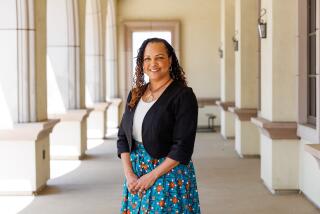Newsletter for Parents of Disabled : Help in Finding Resources for the Handicapped Child
- Share via
Shoshanah Salcedo scoots along the hardwood floors like Sweet Pea in a Popeye comic strip, squealing with excitement and jabbering to visitors. Rolling onto her back for a better look, her delight apparent, she appears so bright and happy it is hard to believe that she is the victim of severe multiple birth defects.
Although nearly 3, Shosh--as she is affectionately called by her parents--cannot walk and is about the size of a baby half her age. She has had five surgeries and faces several more, but she appears happy and is learning all the time, according to her mother, Patricia Salcedo of West Los Angeles.
“She far surpasses anything we expected,” Salcedo said, noting that her daughter was incorrectly diagnosed blind and deaf at birth.
As an accredited learning disabilities teacher, Patricia Salcedo knows how to find and use the many resources available to the developmentally disabled and their families. Among the cadre of professionals she has enlisted to help in her daughter’s development are a vision therapist, an occupational therapist, a speech therapist and a physical therapist.
But even with her educator’s background, the pursuit of services, treatment and opportunities for Shoshanah has not been easy, Salcedo said, and that is why she started Bridges, a newsletter for parents of children with birth defects.
Salcedo is hoping the newsletter, which she plans to publish four times a year, will bridge the gap between services provided by professionals and parents searching for help for their children.
The newsletter--edited especially for parents of children with multiple developmental problems--grew out of her own frustration, Salcedo explained. “The services are out there, but they are so fragmented. An organization could tell me about their own (services), but couldn’t tell me where to go for help with a different problem.”
Salcedo, 29, and her husband, Michael, 32, have gotten no explanation of what might have caused Shoshanah’s problems. The Salcedos also have a 5-year-old daughter, Tovah, who is in kindergarten.
While she was pregnant with Shoshanah, Patricia Salcedo said, “I couldn’t have been more careful. I drank a quart of milk a day, exercised--I didn’t even drink sodas. The most comforting explanation is that life is random. It happens. And it happened to us.”
She would like the newsletter to serve as a clearinghouse of information about resources available to the developmentally disabled in the Los Angeles area. “I am one of many, many parents working to make their children’s lives as happy and productive as possible,” said Salcedo. “There must be 30 or 40 parent groups in L.A. County.”
Doris Hug, Shoshanah’s physical therapist, called Bridges a practical handbook for parents, supplementing information physicians either do not know or do not take the time to discuss.
Describing the newsletter as “non-judgmental,” Hug said it does not advocate one treatment over another. “It is investigative, well-researched, detailed and not vague.”
Salcedo has produced two newsletters so far, the first in December, the second last month and she hopes to have the third ready in July.
Cost for Printing
Costs to Salcedo for printing have been about $1 per copy for the 12-page newsletter, which she has hand-delivered to doctors’ offices and hospitals whenever possible to avoid postage. About 200 copies have been distributed to resource centers and parent groups with which she is familiar, she noted. To cover postage and copying fees, Salcedo is charging $6 for the next three issues.
Citing the trend toward the development of a partnership between professionals and parents, Sheila Wolfe, education specialist for the State of California’s Infant Pre-School Special Education Resource Network, said there is a “real need” for a newsletter to link programs and parents, regardless of the area, the group or the problem.
Even though Southern California has many well-publicized programs for training the very young with disabilities, many people are still not aware of them--and that they are free, according to Jenny Boyd, director of the Infant Family Program for the Foundation for the Junior Blind.
Noted Hug: “Often parents instinctively know they should be doing something, but are lost in negativity and hopelessness. Trust your instincts. Go out and find support.”
Salcedo and her therapists are strong believers in early intervention--teaching children necessary skills at appropriate times in their development, before they get into habits that would prevent them from progressing.
Emphasizing the need for early intervention, Wolfe said, “It is not even a debate anymore. We can no longer say, ‘Let’s wait and see.’ Age 5 is too late to begin.”
Added Boyd: “You can raise a handicapped child or you can raise a child with certain considerations you have to take into account. We have to make these people as independent as possible, giving them skills and self-esteem from the very beginning.”
Salcedo does not anticipate running out of material for her newsletter. She said there are always new laws, new groups, new medical developments and new products and toys for the handicapped that parents want and need to know about.
“Until kids are born without defects,” she said, “there will always be things to write about.”
For information about Bridges call (213) 828-4216.
More to Read
Sign up for Essential California
The most important California stories and recommendations in your inbox every morning.
You may occasionally receive promotional content from the Los Angeles Times.













